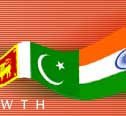|
 The
First Plenary Conference on Democratization, Peace
& Regional Cooperation in South Asia was held
on 20th and 21st September 2004 at The International
Centre, Goa. The Conference was part of the three-year
South Asia project located at The International Centre,
Goa funded by the Ford Foundation with additional
funding from the Ratan Tata Trust. It brought together
around forty delegates from India, Pakistan, Bangladesh,
Nepal and Sri Lanka. The discussions were structured
around the three focal themes with presentations by
the resource person followed by discussions among
the delegates. The basic objective is to involve the
younger generation of South Asians in promoting peace
and regional cooperation in South Asia. The
First Plenary Conference on Democratization, Peace
& Regional Cooperation in South Asia was held
on 20th and 21st September 2004 at The International
Centre, Goa. The Conference was part of the three-year
South Asia project located at The International Centre,
Goa funded by the Ford Foundation with additional
funding from the Ratan Tata Trust. It brought together
around forty delegates from India, Pakistan, Bangladesh,
Nepal and Sri Lanka. The discussions were structured
around the three focal themes with presentations by
the resource person followed by discussions among
the delegates. The basic objective is to involve the
younger generation of South Asians in promoting peace
and regional cooperation in South Asia.
Inaugural Session
In his welcome remarks, Mr. Pratapsingh Rane, President,
Board of Trustees of The International Centre, Goa
appreciated the significance of the present exercise
in creating a breakthrough in peace, economic development
and regional cooperation in the South Asian region.
Highlighting the criticality of the region, he hoped
that through this exercise one can create a roadmap
for South Asia where fundamental freedoms are protected
and peaceful conditions created.
Dr. V.A. Pai Panandiker in his keynote
address pointed out that South Asia, has been for
long perceived as a region of instability and deep
mutual mistrust . As a result, South Asia has lagged
behind, suffering from poverty, deprivation and violence
as the rest of the world has moved ahead. There is
therefore a need to take a critical look at the future
of South Asia which is already home to 1.4 billion
people, likely to become 2.6 billion by 2050. There
are lessons of history that may be studied by the
younger generation which has to look afresh at the
challenges that the region faces. South Asia can have
its own 'end of history' which sets examples where
people with high diversity live in peace and harmony.
It is the younger generation which can show the way
and that is where the present project undertakes a
very vital exercise.
Dr. Rahul Tripathi, giving the overview
of the project pointed out that the three themes selected
were vital to the long term peace and security in
South Asia and had to be seen in an interlinked manner.
In that context the present exercise was very vital
as this was perhaps for the first time such an event
was taking place outside the leading dialogue centres.
Mr. Jayant Chhaya, Director, The
International Centre, Goa, in his vote of thanks hoped
that the rich experiences of the past will help in
guiding the future course of the project. The younger
generation to which the responsibility has been passed
on will make sure that the South Asia Together becomes
a reality. He expressed his gratitude to all who were
involved in the present endeavour.
Session I: Democratisation
Chairperson: Dr. V.A. Pai Panandiker
Paper by: Prof. Kanti Bajpai - "Democratisation
in South Asia"
Prof. Bajpai's paper outlined a framework
within which one could do an audit of the interlocking
balances that sustain democracy and indicated the
threats that confront democratization and democracy.
Given the fact the 'modern democracy' is a recent
thing, South Asians must not consider themselves far
behind in the democratization project. There is a
link between democratization and regional stability
as it affects both internal and external peace. What
happens within a society impacts on people across
boundaries and in South Asia this trend has been quite
manifest. Democracy is to be seen as a political order
in which people elect their leaders, hold them accountable
for their actions and in which individuals and groups
enjoy basic civic and cultural freedoms. For this
a robust democracy should have regular and fair mass
elections, flow of information and ideas to the public
via opposition political parties, press and civil
society organizations that inform wide debate and
decision making and finally constitutionally guaranteed
basic civic and cultural rights. But this requires
a political and social structure which ensures a balance
between sectors and groups.
The discussions following the presentation
encompassed a wide range of issues covering the basic
conceptions of democracy, stakeholders in the democratization
process, applicability of western models and national
security perceptions and democracy. The participants
agreed that democracy should be judged in incremental
terms as a gap existed between the normative conception
of democracy and what actually exists. There has been
a gap between the reality and promise of democracy
in South Asia. The institutions of governance have
often looked upon themselves as rulers and not as
agencies to serve the people. Human security and the
security of the people were not getting adequate attention
in the discourse on democratization in South Asia.
Often national security decision making process remains
highly centralized and authoritarian as the ruling
elites had a tendency to exaggerate the security threat.
It was felt that the debate on applicability of western
models was futile and it was more important to see
whether the democratic institutions that have been
developed are functioning or not. One has to look
for the reasons within if the institutions are not
performing. There was a need to see how best diverse
identities could be accommodated within democratic
politics and South Asia's experiences could serve
as a model for the rest of the world. Democracy and
federalism were also significant issues that had to
be dealt with sensitivity. Another key question would
be how to manage political violence as it has the
potential to undermine democracy. For effective democratic
functioning there should be a National Agenda emerging
out of basic consensus among political parties beyond
which diverse politics should not operate. It was
generally agreed that a reconciliation of democratic
order and recognition of pluralistic realities form
the key premises on which democracy may be sustained
in South Asia.
Session II: Peace and Security
Chairperson: Ambassador Eric Gonsalves
Paper by: Prof. C Raja Mohan - "Peace and Security
in South Asia: Problems and Prospects"
The author pointed out that the last
decade and half had witnessed a certain globalisation
of the economic and security dynamics which had created
a set of new possibilities for the region. The logic
of globalisation is likely to forge a different pace
of regional integration in South Asia which could
imply undoing the economic consequences of partition.
In the security realm, the global attention is more
focused on South Asia than ever because of rising
extremism and potential for nuclear conflict. These
changes may bring about change in perceptions and
attitudes among the South Asian countries with regard
to the way international intervention is seen in the
region. India would be moving away from its traditional
position of opposing external influence in regional
disputes.
The logic of globalisation will reinforce
the primacy of the India's market, thus integrating
with it should be an essential component of the growth
strategy of the neighboring countries. It will be
in India's interest to give unilateral concessions
to its neighbours and should force the pace of regional
integration by giving thrust to positive unilateralism.
In the security sphere, India might still be called
upon to take up the responsibility in case of state
failure in the neighbourhood. But to deal with such
regional conflict situations, some kind of security
multilateralism with India laying a leading role will
have to be there. Thus a mix of positive economic
unilateralism combined with security multilaterism
should be the key parameters of India's policy which
would cater to the collective interests of the South
Asian states.
The discussions following the presentation
extensively covered the issues and scenarios presented
in the paper. It was felt that internal dimensions
of security were equally important in South Asian
context. Role of international community in finding
solutions to subcontinent's disputes was seen as restricted
as the major powers appeared to have a limited influence.
Desirability of Indian intervention in case of state
failure in the neighbourhood was seen as limited and
could further create antagonism within smaller countries.
Perceptions also differed with regard to India extending
unilateral concessions to its smaller neighbours.
As per one view such steps could further marginalize
smaller states as the bigger states may try to monopolise
them. Any intervention, even if on a request may provide
a cover for hegemonism, it was noted. Dialogue within
the region had to be structured around equality, tolerance,
fundamental freedoms and understanding.
South Asian countries often had different
security paradigms and the fact that national security
often becomes part of electoral dynamics further complicates
the issue. Security policy is often moulded by the
interests of the ruling elite, thereby making a emergence
of a collective security system rather difficult.
Besides, globalization was having unequal impact across
the South Asian security region and this could be
a source of threat to South Asian security as well.
Securing peace was not going to be enough, it had
to come with justice to people as well.
The author responded to the comments
by reflecting on the broad structural changes that
have emerged in the region and else where and how
these changes had necessitated a new look at the economic
and security problematique. In any instance of a state
failure in any country in the region, the question
of use of force will come up inevitably. In such kind
of a situation, security multilateralism (rather than
Indian unilateralism) might be the answer. India in
the past has faced the situation of being forced to
take a position amidst countervailing political developments
in the neighbouring countries. It signed treaties
with some smaller countries which looked like alliance
treaties, but they also played a role in providing
security. Human security is certainly a very vital
issue, but one would still need significant changes
in state policy through sustained action and dialogues
could, rather being abstract, provide specific suggestion
in terms of what could be done.
Session III: Regional cooperation
Chairperson: Prof. Muchkund Dubey
Paper by: Prof: Mahendra P Lama - "Regional Cooperation
and Integration in South Asia: Problems and Prospects"
The author noted that regional cooperation
had brought about significant transformations in some
of the region's strategic, political and economic
options. There had been instances where bilateral
conflictual issues had been effectively dealt with
by a favourable situation created by regionalism and
multilateralism. In this context understanding of
the neighbourhood and the regional reform was critical
to interacting with the rest of the world. It had
been noted that no country could individually harness
the resources in commercially viable way. In South
Asia, economic reforms had enhanced the scope of regional
cooperation. The South Asian Association for Regional
Cooperation (SAARC) initiated in 1985 has taken gradual
steps at strengthening regionalism and is now at a
stage where it requires deepening of the process.
There has been a growing assertion on part of the
non-state actors to further strengthen regionalism.
Significantly the Group of Eminent Persons (GEP) established
by Ninth SAARC Summit outlined the roadmap for regional
integration by creating a South Asian Free Trade Area
by 2010, a SAARC Customs Union by 2015 and SAARC Economic
Union by 2020. SAARC has initiated steps towards operationalisation
of SAFTA by 2006.
The paper discussed four critical
issues in the context of regional cooperation in the
realm of trade, technology, investment and energy.
Intra-regional trade as a percentage of the region's
global trade had continued to be low in the recent
years. Besides, India had negligible intra-regional
imports, leading to huge deficit in intra-regional
balance of trade. There was thus a need for greater
integration between trade and investment activity
within the region particularly with regard to smaller
countries. Moreover, unilateral trade liberalization
by India vis a vis its smaller neighbours could also
be a viable policy option. There were areas where
SAARC members could work together at international
fora like WTO where they could enhance their collective
bargaining strength. One such area was the issue of
movement of natural persons. In the field of software
and information technology, South Asian countries
could come together to a common platform to reverse
the flow of technology from the South to North. For
this there would be a prime need to bridge the existing
digital divide in the region. Besides, SAARC could
develop Regional Technology Missions aimed at consolidating
production and productivity in critical sectors of
IT and agriculture.
The presentation was followed by
discussions and critical inputs from the participants.
It was pointed out that at the regional level arrangements
haven't worked well, thus bilateral models may be
used to support regional efforts. India is in a position
to take unilateral steps and that may generate long-term
goodwill. Trade deficits within the region could be
the major stumbling block towards the goal of Economic
Union. Though the logic of globalization had started
impinging on the SAARC process, overcoming political
obstacles still remained challenge. Thus there was
a need to reach out to potential stakeholders to speed
up the process. Multiple regionalisms may be more
beneficial as there is greater pressure to open up,
it also allows SAARC to move at different speeds.
If a country is not willing, one can use sub-regionalism
or trans-regionalism as a viable option. There is
a need to see the potential consequences of China
becoming the second largest economy in the South Asian
region and a strategy of engagement with it will have
to be devised.
In his response, the author pointed
out that often multilateralism is used as a pretext
to deflect attention from a serious involvement at
the regional level. Thus a distinct commitment to
regionalism was needed. The more politically homogeneous
a region is the stronger is the conviction for regional
cooperation. On the issue of political impediments
to regional cooperation, one needed to have a belief
in the paradigm that economic cooperation often provided
the logic for settlement of political differences.
There are other models of successful regional integration
initiatives existing and the best options for South
Asia have been shown to the policy makers. Example
of the SAFTA has shown that despite the initial resistance,
sound economic logic may finally prevail upon the
policy making establishment.
In his concluding remarks the chairperson
pointed to the need to understand the logical compulsion
for South Asia to move ahead. For this the sheer force
of the logic and technical viability of regional cooperation
had to be understood and the message could be carried
back to respective countries to meet the challenges
of globalization. When one is marginalized from mega
groupings, regionalism offers a viable alternative
to negotiate effectively as a group than as individuals
against mega groupings. The deeper aspects of regional
integration in South Asia were mentioned in the GEP
report. Another area where cooperation can be deepened
is monetary and financial cooperation and coordination
of macro-economic policies. SAARC provides a viable
institutionalized mechanism to carry further the process
of enhancing economic cooperation in the region.
Concluding Session
The concluding session consisted
of presentation of reports by the Rapporteurs followed
by discussions among the participants. It was felt
that the present dialogue had enabled a very fruitful
and frank exchange of ideas among the delegates. South
Asia needs to take a realistic view of the present
to arrive at a vision for the future. Such a vision
should have people as the focus as they are the real
stakeholders in democratization, peace and regional
cooperation. The issues and the ideas that came up
during the conference need to be further disseminated.
The themes emerging from the conference would be subsequently
taken up in the working group session in the next
phase of the project.
 Register Online Register Online
|





